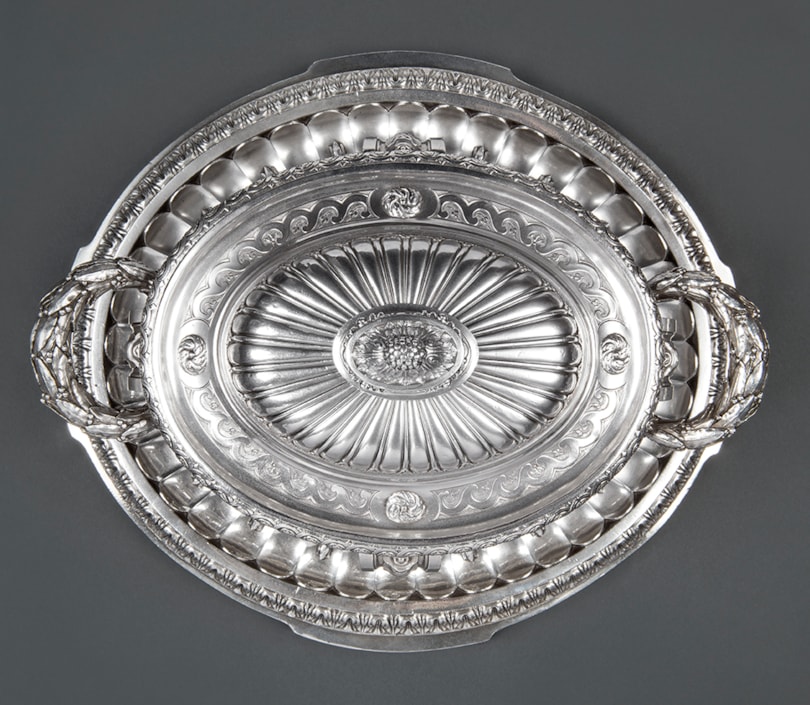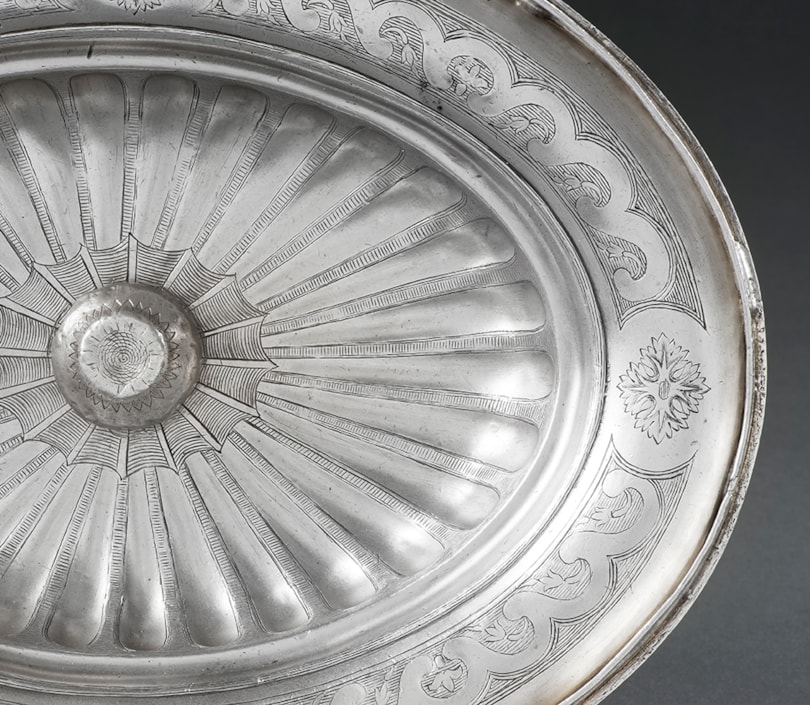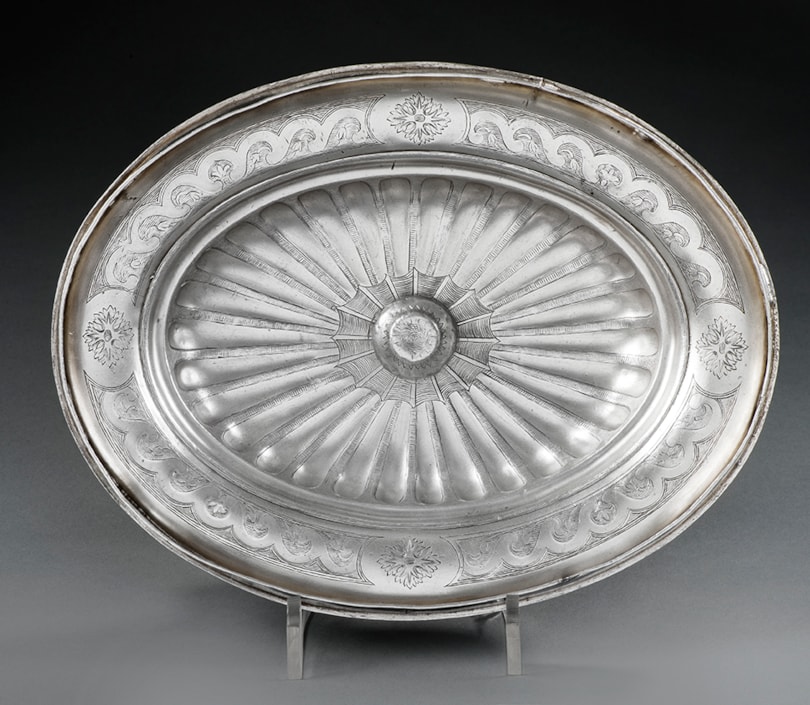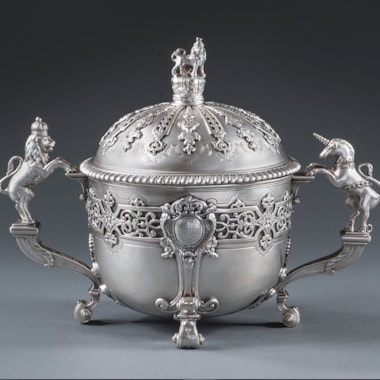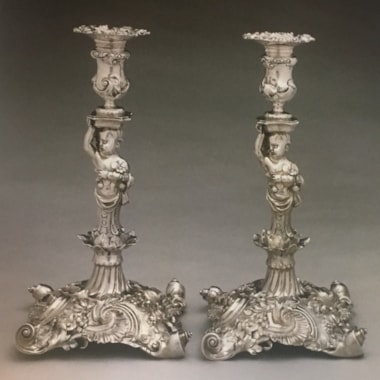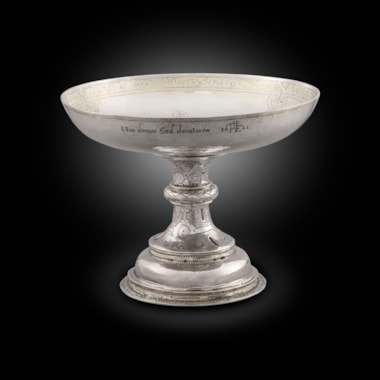Oval, the fluted body on four scrolling feet cast and applied with acanthus foliage and overlapping panels, applied between with berried laurel garlands and with similar handles, with guilloche and rosette rim, the fluted domed cover chased with a band of Vitruvian scrolls on a matted ground, the interior similarly chased, the detachable urn-shaped finial surmounted by an acanthus bud; the oval stand on eight baluster feet, chased with laurel foliage, the domed centre applied with berried husk swags, the body stamped and engraved N 13, on the cover N 15 and underneath the stand N 11.
Gregory Orloff, favourite of Catherine II, led the coup which secured her on the throne as sole ruler and Empress of Russia. She was extremely fond of him but was unwilling to either marry him or give him a political role. She lavished him with titles, lands and gifts including a magnificent silver service.
The story of this service from conception to delivery is well documented through Catherine II’s correspondence with the sculptor Falconet who acted as a middle man in the transaction. Etienne-Maurice Falconet first came to the Russian court in 1766 having been commissioned to create a bronze sculpture of Peter the Great. Recommended by Diderot, a trusted confidant of the Empress, he agreed to act as an intermediary taking only a very moderate fee. On 13 February, 1770, Catherine wrote to him that she had heard he might have some drawings for a table service and that she might be keen to purchase one to accommodate 60 guests. Eventually some 3,000 pieces would be made including eight pots-a-oille, eight tureens, forty-eight pairs of candlesticks, forty-eight dozen plates, thousands of pieces of cutlery and numerous dishes. She ordered more in 1771; warmers, chocolate pots and milk jugs. In Inventories of the Silver of the Court of His Imperial Highness, published in 1907 in St. Petersburg, Baron Foelkersam estimated the total cost of the service to amount to one million two hundred thousand pounds.
Falconet chose as makers the Roettiers, Jacques and Jacques-Nicolas, goldsmiths to the king, Louis XV. Originally from Antwerp, Jacques, born on 29 August 1707, was the son of Nicolas, an engraver at the Mint. Trained in the workshop of Thomas Germain and Nicolas Besnier he became a master in 1733, marrying Besnier’s daughter Marie-Anne the following year. From then on he worked with Besnier taking over his lodging in 1751, which raised his profile and hastened his success. He soon became orfevre ordinaire du roi and resided in the Galerie du Louvre. His son Jacques-Nicolas first joined the workshop as an apprentice in 1752, and then as a partner after becoming master in 1765. After Francois-Thomas Germain’s bankruptcy, the Roettiers were the last goldsmiths living in the Louvre. Both worked actively for the king and his entourage making a table service for Louis XV and a gold dinner service for Madame du Barry.
The negotiations for this service would last several months after the Roettiers gave their preliminary drawings to Falconet. The Empress was very interested indeed in the creative process as well as its mounting cost, complaining of it in a letter dated 25 April 1770, to which Falconet responded on the 28 May, that despite everything, these new drawings demonstrated the best taste in silver.
Once all was agreed, Falconet placed the order through the company, Barral, Chanony & Companie. The first payment was made on 14 January 1771 by Nikolai Khotinskii, a Russian official at the French royal court. The Roettiers commenced work immediately encouraged by Catherine’s enthusiasm, as explained by Falconet in a letter where he assured Catherine that they would do their utmost to achieve their best. The workshop employed many journeymen but not enough to fulfil such a commission on time. The work was therefore in part subcontracted, for example the plates were made by Edme-Pierre Balzac and Claude-Pierre Deville. The service was delivered gradually between May 1771 and September 1775 in 13 or 14 shipments; the main part of the service was completed and delivered within 18 months and carefully inspected by the Empress upon its arrival. In her last letter to Falconet dated 18 August 1771, she declared being not only pleased that the Roettiers themselves were content but that she herself delighted with the twelve silver0gilt pieces she has just received.
Her relationship with Orloff, who had been instructed to negotiate peace with Turks in Fokchany, had sadly deteriorated and in his absence she replaced him with the young Alexander Vassiltchikov. As a parting gift, she gave Gregory the Roettiers silver service as well as another bought from the Danish ambassador for their daily use; as she explained in a letter addressed to Ivan, the eldest of the Orloff brothers. Gregory always kept this service with him, even taking it into exile in Holland. Upon hearing of his death in 1783 Catherine, saddened by the news, wrote to Baron Frederick Grimm that although she had prepared herself for this eventuality, her pain was immense. She bought the service back. A note from her to the aide-de-camp Colonel Buxhoevden requested that the service be inventoried, weighed with the boxes and delivered to Konstantin Kulichij and Ivan Rodinov, in charge of the Imperial silver. She also wished for the Orloff coat-of-arms to be removed as explained in a letter from the chancellor Aleksandr Bezborodko to Gregorii Nikitich, one of the Orloff brothers, adding that Catherine wishes to keep the service for her personal use.
Afterwards the service was kept in the imperial collection until the meltings of the 19th century. What remained was moved to the Winter Palace Museum in 1904 and by 1907 842 pieces were accounted for in Foelkersam’s inventories.
In 1917 after the Revolution, the service became the property of the Russian government who started selling it privately from 1920 through the Antikvariat agency in Berlin. However a large quantity was auctioned by the Berlin auction house Ball & Graupe in September 1930. Jacques Helft bought several pieces for large sums, for example a soup tureen for 30,000 reichmarks. In 1935 he sold pieces on to the renowned silver collector Moise de Camondo; a pair of pot-a-oille now in the muse des Arts Decoratifs, Paris.
Today only 230 pieces of this vast service are known. Some are exhibited in eminent museums such as the Hermitage, St. Petersburg, the Kremlin Armoury, Moscow, the Metropolitan Museum, New York and the Louvre, Paris. Others are in private collections and have appeared in landmark sales: David-Weill in Paris in 1971, Jaime Ortiz-Patino in new York in 1992, the collection of an amateur in Paris in 2004, Paul Louis Weiller in Paris in 2011 and Djahanguir Riahi in London in 2012.
The Orloff Soup Tureens – Tureens were designed as the focal point of a service and as such should demonstrate the talent of the goldsmith. In this vast service, the tureens are relatively small in number but they follow this rule.
They are numbered 1 to 8 for the circular pots-a-oille and 9 to 16 for the oval soup tureens; they were the first pieces sent to Russia. They were made in several sections: four parts formed the body and four the feet with decorative elements applied and the handle attached by a thread and nut, the stand is made up of one piece to which the feet are added. Of the eight pots-a-oille, one entered the Louvre’s collection in 1933, a pair is in the muse des Arts Decoratifs and another is in the Metropolitan Museum in New York. Out of the eight soup tureens, only one is in the Kremlin Armoury in Moscow, the rest are in private collections or have been melted down.
Catherine II, Empress of Russia (1729-1796)
Given to Count Gregory Orloff (1734-1783) after 1772
Catherine II of Russia 1784, and by descent in the imperial collections to Nicolas II (1868-1918) until 1917
Soviet Government until 1917
The model of the soup tureen is illustrated in Baron A. de Foelkersam, Inventaire de l’argenterie conserve dans les garde-meubles des palais imperiaux, St. Petersburg, 1907, pl. 32.
You May Also Like




































































